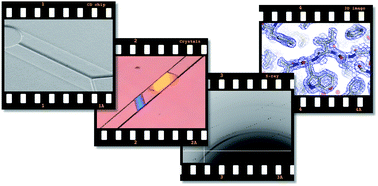Microfluidic chips for the crystallization of biomacromolecules by counter-diffusion and on-chip crystal X-ray analysis
Abstract
Microfluidic devices were designed to perform on micromoles of biological

Maintenance work is planned for Wednesday 1st May 2024 from 9:00am to 11:00am (BST).
During this time, the performance of our website may be affected - searches may run slowly and some pages may be temporarily unavailable. If this happens, please try refreshing your web browser or try waiting two to three minutes before trying again.
We apologise for any inconvenience this might cause and thank you for your patience.
* Corresponding authors
a
Architecture et réactivité de l'ARN, Université de Strasbourg, CNRS, IBMC, 15 rue René Descartes, Strasbourg, France
E-mail:
c.sauter@ibmc.u-strasbg.fr
b
FEMTO-Innovation /FEMTO-ST, UMR CNRS 6174 and CTMN, 32 avenue de l'observatoire, Besançon, France
E-mail:
chantal.khanmalek@femto-st.fr
c Institute for Materials Research I, Forschungszentrum Karlsruhe, P.O. Box 3640, Karlsruhe, Germany
d Lyon Institute of Nanotechnology, INL, CNRS UMR5270, Université de Lyon, Villeurbanne, France, France
e Groupe Synchrotron, Institut de Biologie Structurale, CEA, CNRS, Université Joseph Fourier, 41 rue Jules Horowitz, Grenoble Cedex 1, France
Microfluidic devices were designed to perform on micromoles of biological

 Please wait while we load your content...
Something went wrong. Try again?
Please wait while we load your content...
Something went wrong. Try again?
K. Dhouib, C. Khan Malek, W. Pfleging, B. Gauthier-Manuel, R. Duffait, G. Thuillier, R. Ferrigno, L. Jacquamet, J. Ohana, J. Ferrer, A. Théobald-Dietrich, R. Giegé, B. Lorber and C. Sauter, Lab Chip, 2009, 9, 1412 DOI: 10.1039/B819362B
To request permission to reproduce material from this article, please go to the Copyright Clearance Center request page.
If you are an author contributing to an RSC publication, you do not need to request permission provided correct acknowledgement is given.
If you are the author of this article, you do not need to request permission to reproduce figures and diagrams provided correct acknowledgement is given. If you want to reproduce the whole article in a third-party publication (excluding your thesis/dissertation for which permission is not required) please go to the Copyright Clearance Center request page.
Read more about how to correctly acknowledge RSC content.
 Fetching data from CrossRef.
Fetching data from CrossRef.
This may take some time to load.
Loading related content
